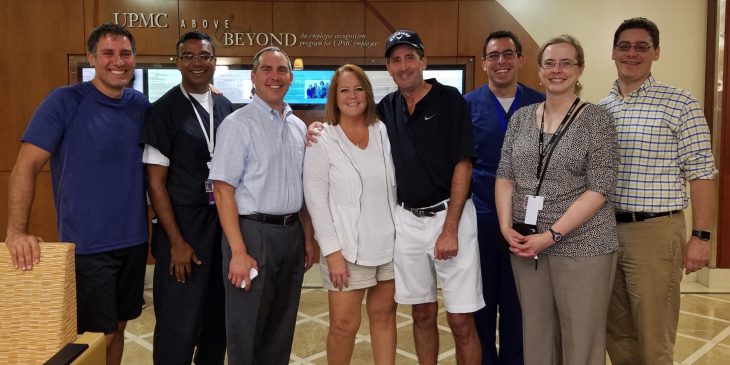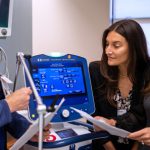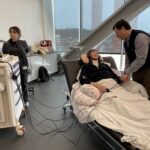It was a regular day during Pittsburgh’s sweltering summer of 2017. Bill Norton was heading outside when he called his wife, Amy, to complain of having chest pains. Suddenly, she heard Bill collapse.

Bill and Amy Norton with their dog, Scruffles.
Amy found Bill on the floor of their living room, a team of paramedics swarming around him, trying to bring her husband back to life. Minutes later, doctors got his heart beating again, but the bigger issue remained – would his brain ever recover?
Bill spent 31 days in intensive care, no brain activity in sight.
“The ICU doctors said, there’s one more test we want to do to see if there is any brain activity,” Amy remembers. “I’ll never forget. They came back to me, and they had tears in their eyes and said that they were wrong – there’s some activity, so they’ll keep going.”
Dr. Amy Wagner, a professor of physical medicine and rehabilitation at the University of Pittsburgh, was a frequent guest by Bill’s bedside. During the months-long stay, initially at UPMC Presbyterian and later at UPMC Mercy, Wagner and others from the brain injury rehabilitation team helped Bill recover from his brain injury – to the point that he can now not only read and write, but also work and drive a car.
Norton’s recovery is, in part, a credit to the Brain Injury Medicine (BIM) consult service at UPMC – a unique program led by Wagner that focuses on providing some of the sickest neurological patients in the world with neurorehabilitation recommendations needed to jump-start their functional recovery.

Bill golfing after his recovery from cardiac arrest.
Last month, Wagner published findings about the service in PM&R, the official scientific peer-reviewed journal of the American Academy of Physical Medicine and Rehabilitation.
Wagner and her team found that brain injury patients who were supported by the BIM consult service spent fewer days in acute care, remained in rehabilitation without interruptions for longer periods and were more likely to emerge from a vegetative state compared to patients who received standard physical medicine care.
Additionally, Wagner found that the service had economic benefits, too, reducing the cost of unplanned patient readmissions by nearly 60%.
“Our goal is heavily focused on coordination and continuity of care,” noted Wagner. “During their time in acute care, some patients end up being transferred to multiple hospital units, and we can connect with each new service team and advocate on a patient’s behalf.”
Years after that scary incident, Amy credits her husband’s successful recovery to Wagner, the BIM consult service, and Bill’s inpatient treatment team. Bill is now golfing, traveling, working and living his life much as he did before his cardiac arrest.
Wagner believes that, in addition to the great ICU and post-cardiac arrest care Bill received, the continuity of care model provided through the BIM consult service was crucial in the early days of Bill’s hospital course. She is now hoping to expand the service.
“Bill could have easily been a candidate for a long-term care facility, which would have been devastating to both of us,” his wife said. “If not for Dr. Wagner knowing what to look for and giving him the chance that she did, we could have easily ended up that way.”
To find out more about the BIM Service, call 412-648-6666.









